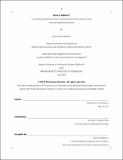| dc.contributor.advisor | Christoph F. Reinhart. | en_US |
| dc.contributor.author | Saratsis, Emmanouil | en_US |
| dc.contributor.other | Massachusetts Institute of Technology. Department of Architecture. | en_US |
| dc.date.accessioned | 2015-10-14T14:35:47Z | |
| dc.date.available | 2015-10-14T14:35:47Z | |
| dc.date.copyright | 2015 | en_US |
| dc.date.issued | 2015 | en_US |
| dc.identifier.uri | http://hdl.handle.net/1721.1/99254 | |
| dc.description | Thesis: S.M., Massachusetts Institute of Technology, Department of Architecture, 2015. | en_US |
| dc.description | This electronic version was submitted by the student author. The certified thesis is available in the Institute Archives and Special Collections. | en_US |
| dc.description | Title as it appears in MIT Commencement Exercises program, June 5, 2015: Daylit Density : a simulation-based framework for performance-aware zoning and real estate development. Cataloged from student-submitted PDF version of thesis. | en_US |
| dc.description | Includes bibliographical references (pages 85-86). | en_US |
| dc.description.abstract | Population growth and related space constraints have led to a planning paradigm that promotes living and working in high-density urban areas. Increasing urban density, however, leads to a conflict between space-use efficiency and access to daylight. To manage this conflict and to ensure sufficient solar access, cities have traditionally relied on zoning guidelines that propose simple, two-dimensional geometric evaluation techniques. This practice seems antiquated in times when computer aided design tools enable architects to test designs before construction. Recent advances in building performance simulation software allow us to compute annual climate-based daylight performance metrics of urban environments accurately, in high spatial resolution and in a timely manner. Given that zoning requirements as well as massing design decisions at the urban planning level may make or break the long-term daylighting potential of a whole neighborhood, the adoption of these tools by zoning boards and planners seems particularly relevant. This manuscript therefore presents a simulation-based framework for formulating more nuanced prescriptive zoning rules, along with a performance-based approach for developers and planners interested in exploring innovative urban massing solutions. The framework is used to evaluate the daylighting performance of common and innovative urban block typologies in New York City. The performance of the investigated massing designs varies; in some cases the designs significantly outperform existing strategies, supporting urban densities that are twice as high as current zoning maxima. Findings are illustrated using a case study and compiled into a set of recommendations for zoning boards, planners and real estate developers towards more sustainable management of solar access at the urban scale. | en_US |
| dc.description.statementofresponsibility | by Emmanouil Saratsis. | en_US |
| dc.format.extent | 88 pages | en_US |
| dc.language.iso | eng | en_US |
| dc.publisher | Massachusetts Institute of Technology | en_US |
| dc.rights | M.I.T. theses are protected by copyright. They may be viewed from this source for any purpose, but reproduction or distribution in any format is prohibited without written permission. See provided URL for inquiries about permission. | en_US |
| dc.rights.uri | http://dspace.mit.edu/handle/1721.1/7582 | en_US |
| dc.subject | Architecture. | en_US |
| dc.title | Daylit density : a simulation-based framework towards performance-aware zoning and real estate development | en_US |
| dc.title.alternative | Daylit Density : a simulation-based framework for performance-aware zoning and real estate development | en_US |
| dc.title.alternative | Day lit density | en_US |
| dc.type | Thesis | en_US |
| dc.description.degree | S.M. | en_US |
| dc.contributor.department | Massachusetts Institute of Technology. Department of Architecture | |
| dc.identifier.oclc | 922929038 | en_US |
